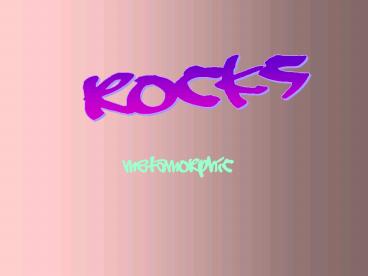Metamorphic - PowerPoint PPT Presentation
1 / 16
Title:
Metamorphic
Description:
The parent rock can be either sedimentary, igneous, or even another ... Foliate comes from the Latin word that means sheets. Shale is changed into slate. ... – PowerPoint PPT presentation
Number of Views:37
Avg rating:3.0/5.0
Title: Metamorphic
1
Rocks
- Metamorphic
2
- Metamorphic rocks form from heat and pressure
changing the original or parent rock into a
completely new rock. - The parent rock can be either sedimentary,
igneous, or even another metamorphic rock. The
word "metamorphic" comes from Greek and means "To
Change Form". - This changing of rock types is called the "Rock
Cycle".
3
- There are 3 main agents that cause metamorphism (
we will discuss two) - 1. Temperature increases can be caused by
layers of sediments being buried deeper and
deeper . The deeper the layers are buried the
hotter the temperatures become. The great weight
of these layers also causes an increase in
pressure, which in turn, causes an increase in
temperature. - The descending of rock layers at subduction zones
causes metamorphism in two ways - the shearing effect of the plates
- the rock next to the melted rock can be changed
by the heat and become a metamorphic rock. - The diagram above shows you where metamorphic
rock (YELLOW ZONE) can be produced at a
subduction zone. - 2. There are 3 factors that cause an increase in
pressure - The huge weight of overlying layers of sediments.
- Stresses caused by plates colliding in the
process of mountain building. - Stresses caused by plates sliding past each other
- Metamorphism can be instantaneous as in the
shearing of rocks at plate boundaries or can take
millions of years as in the slow cooling of magma
buried deep under the surface of the Earth.
4
- There are three ways that metamorphic rocks can
form., Contact, Regional, and Dynamic
metamorphism. - Contact Metamorphism occurs when magma comes in
contact with an already existing body of rock - Regional Metamorphism occurs over a much larger
area. Regional metamorphism is caused by large
geologic processes such as mountain-building. - Dynamic Metamorphism also occurs because of
mountain-building. These huge forces of heat and
pressure cause the rocks to be bent, folded,
crushed, flattened, and sheared. - Metamorphic rocks are almost always harder than
sedimentary rocks. They form the roots of many
mountain chains.
5
- Metamorphic rocks are divided into two
categories- Foliates and Non-foliates. - Foliates are composed of large amounts of micas
and chlorites - have very distinct cleavage.
- will split along cleavage lines that are parallel
to the minerals that make up the rock. - Example Slate
- Foliate comes from the Latin word that means
sheets
6
- Shale is changed into slate.
- Slate is a fine-grained metamorphic rock with
perfect cleavage that allows it to split into
thin sheets. Slate usually has a light to dark
brown streak. Slate is produced by low grade
metamorphism, which is caused by relatively low
temperatures and pressures. - Slate is not very hard and can be carved easily.
7
- Schist is a medium grade metamorphic rock.
- subjected to more heat and pressure than slate,
which is a low grade metamorphic rock. - because it has been squeezed harder than slate it
is often found folded and crumpled. - Schists are usually named by the main minerals
that they are formed from such as Bitotite mica
schist, hornblende schist, garnet mica schist,
and talc schist - Click to see the parent rock!
8
- Click to see the next grade of metamorphic rock!
9
- Gneiss is a high grade metamorphic rock.
- Gneiss is coarser than schist and has distinct
banding. - The minerals that compose gneiss are the same as
granite. - Gneiss can be used by man as paving and building
stone. - Now click to see the similarities with granite.
10
- Click to study the second group of metamorphic
rocks
11
- Non-Foliates are metamorphic rocks that have no
cleavage at all. - Quartzite and marble are two examples
- Click to learn about metamorphosed
sandstone!
12
- Quartzite is composed of sandstone that has been
metamorphosed. - is much harder than the parent rock sandstone.
- Click to see its parent rock, notice the
similarities between the rocks.
13
- Now click to see a beautiful specimen of
metamorphic rock!
14
- Marble is metamorphosed limestone or dolomite.
- Marble has many color variances due to the
impurities present at formation. - Marble is much harder than its parent rock.
- Makes it a good material for use as a building
material, making sink tops, bathtubs, and a
carving stone for artists. - Marble is quarried in Vermont, Tennessee,
Missouri, Georgia, and Alabama. - Click to see the parent rocks of marble.
15
- Click on the space bar to begin the questions to
this lesson.
16
- Write the answers to the following questions in
complete sentences on a piece of paper. - 1.Write a definition in your own words of what a
metamorphic rock is. - 2. What are the two agents of metamorphism?
- 3. What are the three types of metamorphism?
- 4. In your own words write a definition of the
rock cycle.































